LOW WEIGHT AND LUXURY
Page 112
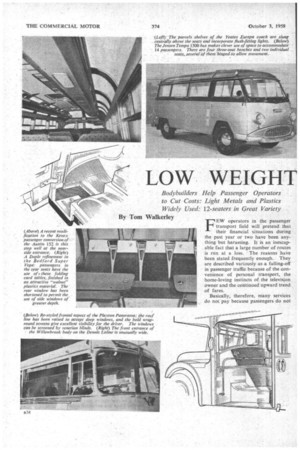
Page 113
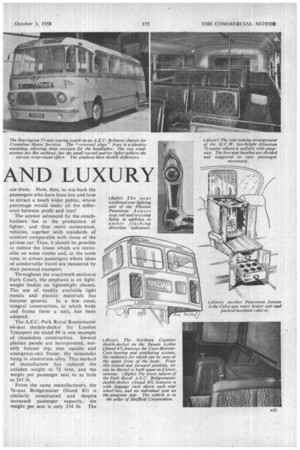
Page 114
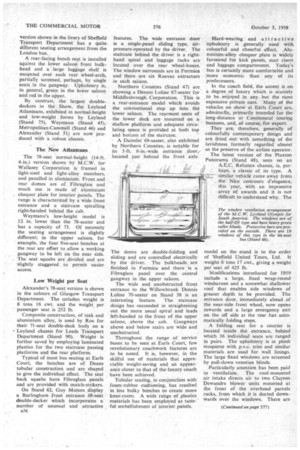
Page 117
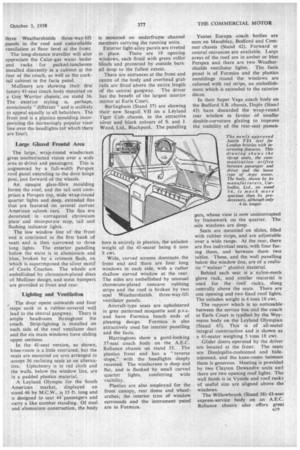
Page 118
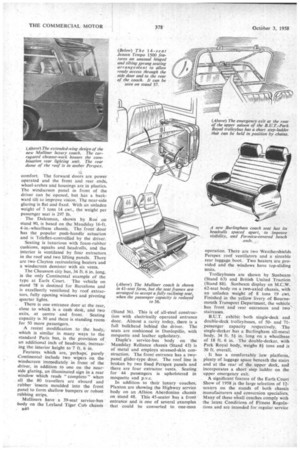
Page 119
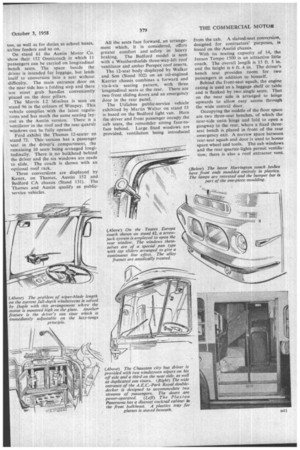
If you've noticed an error in this article please click here to report it so we can fix it.
Bodybuilders Help Passenger Operators to Cut Costs: Light Metals and Plastics Widely Used: 12-seaters in Great Variety By Tom Walkerley '
FEW operators in the passenger transport field will pretend that their financial situations during the past year or two have been anything but harassing. It is an inescapable fact that a large number of routes is run at a loss. The reasons -have been stated frequently enough. They are described variously as •a falling-off in passenger traffic because of the convenience of personal transport, the home-loving instincts of the television owner and the continued upward trend of fares.
Basically, therefore, many services do not -pay because passengers do not
use them. How, then, to win back the passengers who have been lost and how to attract a much wider public, whose patronage would make all the difference between profit and loss?
The answer advanced by the coachbuilders lies in the production of lighter, and thus more economical, vehicles, together with standards of comfort comparable with those of the private car. Thus, it should be possible to reduce the losses which are inevitable on some routes and, at the same time, to attract passengers whose ideas of comfortable travel are measured by their personal transport.
Throughout the coachwork section at Earls Court, the emphasis is on lightweight bodies on lightwight chassis. The use of readily available light metals and plastics materials has become general. In a few cases, integral construction, in which body and frame form a unit, has been adopted.
The A.E.C.-Park Royal Routemaster 64-seat double-decker for London Transport on stand 89 is one example of chassisless construction. Several plastics panels are incorporated, notably bonnet top, seat squabs and emergency-exit frame, the remainder being in aluminium alloy. This method of manufacture has reduced the unladen weight to 7+ tons, and the weight per passenger seat to as little as 245 lb.
From the same manufacturers, the 76-seat Bridgemaster (Stand 85) is similarly constructed and despite increasedpassenger capacity, the weight per seat is only 234 lb. The
(Above) The Northern Counties double-decker on the Dennis Loline (Stand 47) features the Cave-BrowneCave heating and ventilating system, the radiators for which can be seen at . the upper front of the body. From this central and forward position, air can be ducted to both upper ath lower. saloons. (Right) The lower saloon of the Park Royal A.E.C. Bridgemaster double-decker (Stand 85) features a wide luggage rack above each rear wheel box, and an individual seat on the gangway side. The vehicle is to the order of Sheffield Corporation.
version shown in the livery of Sheffield Transport Department has a quite different seating arrangement from the London bus.
A rear-facing bench seat is installed against the lower saloon front bulkhead and a large luggage shelf is mounted over each rear wheel-arch, partially screened, perhaps, by single seats in the gangway. Upholstery is, in general, green in the lower saloon and red in the upper.
By contrast, the largest doubledeckers in the Show, the Leyland Atlanteans, exhibited in normal-height and low-weight forms by Leyland (Stand 75), Weymann (Stand 45),, Metropolitan-Cammell (Stand 46) and Alexander (Stand, are now produced with a robust chassis.
The New Atianteans
The 78-seat normal-height (14-ft. 4-in.) version shown by M.C.W. for Wallasey Corporation is framed in light-steel and light-alloy members, and panelled in aluminium. Front and rear domes are of Fibreglass and much use is made of aluminium chequer plate for interior panels. The range is characterized by a wide front entrance and a staircase spiralling right-handed behind the cab.
Weymann's low-height model is 12 in. lower than the 78-seater and has a capacity of 73. Of necessity the seating arrangement is slightly different; in the upper saloon, for example, the four five-seat benches at the rear are offset to allow a working gangway to be left on the near side. The seat squabs are divided and are slightly staggered to permit easier. access.
Low Weight per Seat
Alexander's 78-seat version is shown in the colours of Glasgow Transport Department. The unladen weight is 8 tons 16 cwt. and the weight, per passenger seat is 252 lb.
Composite construction, of teak and aluminium alloy, is used by Roe for their 71-seat double-deck body on a Leyland chassis for Leeds Transport Department (Stand 90). Weight is further saved by employing laminated plastics for the two staircase passing platforms and the rear platform.
Typical of most bus seating at Earls Court, the benches are of Deans tubular construction and are shaped to give the individual effect. The seat back squabs have Fibreglass panels and are provided with match-strikers.
On Stand 62, Guy Motors. display a Burlingham front entrance 68-seat double-decker which incorporates a number of unusual and attractive
B36 features. The wide entrance door is a single-panel sliding type, air-. pressure-operated by the driver. The staircase behind the driver is a righthand spiral and luggage racks are located over the rear wheel-boxes. The window surrounds are in Formica and there are six Roevac extractors in each saloon.
Northern Counties (Stand 47) are showing a Dennis Loline 67-seater for Middlesbrough Corporation. This is a rear-entrance model which avoids the conventional step up into the lower saloon. The rearmost seats of the lower deck are mounted on a shallow platform and adequate circulating space is provided at both top and bottom of the staircase.
A Daimler 69-seater, also exhibited by Northern Counties, is notable for its 3-ft. 8-in.-wide entrance door,located just behind the front axle.
The doors are double-folding and sliding and are controlled electrically by the driver. The bulkheads are finished in Formica and there ‘is a Fibreglass panel over the central gangway in the upper saloon.
The wide and unobstrueted front entrance to the Willowbrook Dennis Loline 70-seater on Stand 38 is an interesting feature. The staircase design has succeeded in straightening out the more usual spiral and leads left-handed to the front of the upper saloon, above the cab. Gangways above and below stairs are wide and unobstructed.
Throughout the range of service buses to be seen at Earls Court, few revolutionary coachwork features are to be noted. It is, however, in the skilful use of materials that appreciable weight-saving and an appearance closer to that of the luxury coach have been achieved.
Tubular seating, in conjunction with foam-rubber cushioning, has resulted in less bulky benches to create more knee-room. A wide range of plastics materials has been employed as tasteful embellishment of interior panels. Hard-wearing and attractive upholstery is generally used with colourful and cheerful effect. Aluminium-alloy chequer plate is widely favoured for kick panels, stair risers and luggage compartments. Today's bus is certainly more comfortable and more economic than any of its predecessors. _ In the coach field, the accent is on a degree, of luxury which is scarcely to be, enjoyed in any , but the most expensive private cars. Many of the vehicles on show at Eirls Court are, admittedly, primarily intended for the long-distance or Continental touring business, and, of course, for export.
They are, therefore, generally of colourfully contemporary design and are fitted out with something of the lavishness formerly regarded almost as the preserve of the airline operator.
The latest version of the Plaxton Panorama (Stand 48), seen on an A.E.C. Reliance chassis, is, per haps, 'a classic of its type. A
Icr0 similar vehicle came away from
• . the Nice coneours .d'elegance, this year, with an impressive array of awards and it is not difficult to understand why. The
model on the stand is to the order of 'Sheffield United Tours, Ltd. It weighs 6tons 17 cwt., giving a weight
per seat of 425 lb.
Modifications introduced for 1959 include a large, fixed wrap-round windscreen and a somewhat shallower roof that enables side windows of greater depth to be provided. The entrance door, immediately ahead of the near-side front wheel, now opens inwards and a large emergency exit on the off side at the rear has auto matically folding steps.
A folding seat for a courier is located inside the entrance, behind which 36 individual seats are ranged in pairs. The upholstery is in plush
moquette with p.v.c. trim and similar materials are used for wall linings. The large fixed windows are screened
by pull-down venetian blinds.
Particularly attention has been paid to ventilation. The roof-mounted air intake directs air to two Clayton Dewandre blower units mounted at the front of the overhead parcels racks, from which it is ducted downwards over the windows. There are
three Weathershields three-way-lift panels in the. roof and controllable ventilation at floor level at the front.
The long-distance traveller will also appreciate the Calor-gas water boiler and racks for packed-luncheons installed discreetly in a cabinet at the rear of the coach, as well as the cocktail cabinet in the facia panel.
Mulliners are showing their first luxury 41-seat coach body mounted on a Guy Warrior chassis, on stand 36. The exterior styling is, perhaps,
consciously " different " and is unlikely, to appeal equally to all beholders. The front end is a plastics moulding incorporating the increasingly popular visor
line over the headlights (of which there are four).
Large Glazed Frontal Area
The large, wrap-round windscreen gives unobstructed vision over a wide area to driver and passengers. This is augmented by a full-width Perspex roof panel extending to the door hinge post, just forward of the wheels.
An opaque glass-fibre moulding forms the roof, and the tail unit comprises a Perspex top, wide wrap-round quarter lights and deep, extended fins that are featured on several current American saloon cars. The fins are decorated in corrugated chromium plate and incorporate stop, tail and flashing indicator lights.
The low window line of the front end is continued to the first bank of seats and is then narrowed to three long lights. The exterior panelling below the waist is in aluminium and blue, broken by a crimson flash, on which is superimposed the silver motif of Castle Coaches. The wheels are embellished by chromium-plated discs of Mulliner design, and stout bumpers are provided at front and rear.
Lighting and Ventilation
The door opens outwards and four steps sunk in a rubber-covered well lead to the c'entral gangway. There is ample headroom 'throughout the coach. Strip-lighting is installed on each side of the roof ventilator duct and the six main windows have sliding upper sections.
In the 41-seat version, as shown, knee-room is a little restricted, but the seats are mounted on arcs arranged to accept 36 reclining seats as an alternative. Upholstery is in red cloth and the walls, below the window line, are in a padded plastics material.
A Leyland Olympic for the South American market, displayed on stand 46 by M.C.W., is 35 ft. long and is designed to seat 44'passengers and carry a like number standing. Of steel and aluminium construction, the body is mounted on underframe channel members carrying the running units.
Exterior light-alloy panels are riveted in place. There are 19 opening windows, each fitted with green roller blinds and protected by outside bars: all drop to the fullest extent.
There are entrances at the front and centre of the body and overhead grab rails are fitted above the entire length of the central gangway. The driver has the benefit of the largest interior mirror at Earls Court.
Burlingham (Stand 37) are showing their new Seagull VII on a Leyland Tiger Cub chassis, in the attractive silver and black colours of S. and J. Wood, Ltd., Blackpool. The panelling
here is entirely in plastics, the unladen weight of the 41-seater being 6 tons 9 cwt.
Wide, curved screens dominate the front end and there are four long windows in each side, with a rather shallow curved window at the rear. The sides are embellished by unusual chromium-plated concave rubbing strips and the roof is broken by two opal Weathershields three-way-lift ventilator panels.
Aircraft-type seats are upholstered in grey patterned moquette and p.v.c. and have Formica bench ends of pleasing design. Formica is also attractively used for interior panelling and the facia.
Harringtons show a good-looking 37-seat coach body on the A.E.C. Reliance chassis on stand 35. The plastics front end has a "reverse slope," with the headlights deeply recessed. The windscreen is deep and flat, and is flanked by small curved quarter lights, conferring wide visibility.
Plastics are also employed for the front canopy, rear dome and wheelarches; the interior trim of window surrounds and the instrument panel are in Formica. Yeates Europa coach bodies are seen on Maudslay, Bedford and Cornmer chassis (Stand 42). Forward or central entrances are available. Large areas of the roof are in amber or blue Perspex and there are two Weathershields ventilator lights. The facia panel is of Formica and the plastics mouldings round the windows are relieved with red strips, an embellish ment which is extended to the exterior decor.
In their Super Vega coach body on the Bedford S.B. chassis, Duple (Stand 43) have -discarded the wrap-round
rear window in favour of smaller double-curvature glazing to improve the visibility of the rear-seat passen gers, whose view is now uninterrupted by framework on the quarter. The side windows are deep.
Seats are mounted on slides, filled with rubber strips, and are adjustable over a wide range. At the rear, there are five individual seats, with four facing them, and between them two tables. These, and the wall panelling below the window line, are of a realistic " walnut " plastics material.
Behind each seat is a nylon-mesh glove rack, and similar material is used for the roof racks, slung centrally above the seats. There are one opening and two fixed roof lights. The unladen weight is 4 tons 18 cwt.
The rapport which is so noticeable between the service bus and the coach at Earls Court is typified by the Weymann body on the Leyland Olympian (Stand 45). This is of all-metal integral construction and is shown as a 41-seater weighing 5 tons 18 cwt.
Glider doors operated by the driver are located at the front: The seats are Dunlopillo-cushioned and hidetrimmed, and the knee-room between them is generous. Heating is provided by two Clayton Dewandre units and there are two opening roof lights. The wall finish is in Vynide and roof racks of useful size are aligned above the windows.
The Willowbrook (Stand 38) 43-seat express-service body on an A.E.C.
Reliance chassis also offers great
comfort. The forward doors are power operated and the front and rear ends, wheel-arches and housings are in plastics. The windscreen panel in front of the driver can be opened, but has a backward tilt to improve vision. The near-side glazing is flat and fixed. With an unladen weight of 5 tons 14 cwt., the weight per passenger seat is 297 lb.
The Dalesman, shown by Roe on stand 90, is based on the fvlaudslay 16-ft. 4-in.-wheelbase chassis. The front door has the popular push-handle actuation and is Telefiex-controlled by the driver.
Seating is luxurious with foam-rubber cushions, squabs and headrolls, and the interior is ventilated by four extractors in the roof and two lifting panels. There are two Clayton recirculating heaters and a windscreen demister with six vents.
The Chausson city bus, 34 ft. 6 in. long, is the only Continental example of the type at Earls Court. The vehicle on stand 78 is destined for Barcelona and is excellently ventilated by roof extractors, fully opening windows and pivoting quarter lights.
There is one entrance door at the rear, close to which is a cash desk, and two exits, at centre and front. Seating capacity is 30 and there is standing room for 50 more passengers.
A recent modification to the body, which is similar in many ways to the standard Paris bus, is the provision of an additional inch of headroom, increasing the interior height to 7 ft. 6 in.
Features which are, perhaps, purely Continental include two wipers on the windscreen immediately in front of the driver, in addition to one on the nearside glazing, an illuminated sign in a rear window which reads " completo " when all the 80 travellers are aboard and rubber inserts moulded into the front panel to form shallow bumpers or robust rubbing strips. '
Mulliners have a 39-seat service-bus body on the Leyland Tiger Cub chassiS n4(1 (Stand 36). This is of all-steel construction with electrically operated entrance door. Almost a rarity today, there is a full bulkhead behind the driver. The seats are cushioned in Dun lopillo, with moquette and leather upholstery.
Duple's service-bus body on the Maudslay Reliance chassis (Stand 43) is of metal and employs stressed-skin construction. The front entrance has a twopanel glider-type door. The roof line is broken by two fixed Perspex panels and there are four extractor vents. Seating for 44 passengers is upholstered in moquette and p.v.c.
In addition to their luxury coaches, Plaxton are showing the Highway service body on an Albion Aberdonian chassis on stand 48. This 45-seater has a front entrance and is one of several examples that could be converted to one-man operation. There are two Weathershields Perspex roof ventilators and a sizeable rear luggage boot. Two heaters are provided and the windows have top-sliding units.
Trolley buses are shown by Sunbeam (Stand 63) and British United Traction (Stand 88). Sunbeam display an M.C.W. 62-seat body on a two-axled chassis, with an unladen weight of 8 tons 19 cwt. Finished in the yellow livery of Bournemouth Transport Department, the vehicle, has front and rear entrances and two staircases.
B.U.T. exhibit both single-deck and double-deck trolleybuses, of 50and 71passenger capacity respectively, The single-decker has a Burlingham all-metal body, 34 ft. 5+ in. long on a wheelbase of 18 ft. 6 in. The double-decker, with Park Royal body, weighs 8+ tons and is 30 ft. overall.
It has a comfortably low platform, plenty of luggage space beneath the stairs and at the rear of the upper deck, and incorporates a short step ladder on the upper emergency exit.
A significant feature of the Earls Court Show of 1958 is the large selection of 12seaters on the stands of both chassis manufacturers and conversion specialists. Many of these st.nall coaches comply with the latest Conditions of Fitness Regulations and are intended for regular service
use, as well as for duties as school buses, airline feeders and so on.
On stand 61 the Austin Motor Co. show their 152 Omnicoac,h in which 11 passengers can be carried on longitudinal bench seats. The space beside the driver is intended for luggage, but lends itself to conversion into a seat without ilifficulty. The main entrance door on The near side has a folding step and there are stout grab handles conveniently placed on the door pillars.
The Morris J.2 Minibus is seen on stand 96 in the colours of Wimpey. This vehicle complies with the latest regulations and has much the same seating layout as the Austin version. There is a ventilator in the roof and the rear quarter windows can be fully opened.
Ford exhibit the Thames 12-seater on stand 72. Thisversion has a passenger seat in the driver's compartment, the remaining 10 seats being arranged longitudinally. There is no bulkhead behind the driver and the six windows are made to slide. The coach is shown with an optional roof rack.
Three conversions are displayed by Kenex, on Thames, Austin 152 and Bedford CA chassis (Stand 131). 'The Thames and Austin qualify as publicservice vehicles, All the seats face forward, an arrangement which, it is considered, offers greater comfort and safety in heavy braking. The Bedford model is seen with a Weathershields three-way-lift roof ventilator and amber Perspex roof inserts.
The 12-seat body displayed by Walker and Son (Stand 102) on an oil-engined Karrier chassis combines a forward and vis-a-vis seating pattern, with three longitudinal seats at the rear. There are two front sliding doors and an emergency door in the rear panel.
The Utilabus public-service vehicle exhibited by Martin Walter on stand 55 is based on the Bedford light van. Here the driver and front passenger occupy the cab seats, the remainder sitting face-toface behind. Large fixed windows are provided, ventilation being introduced from the cab. A slatted-seat conversion, designed for contractors' purposes, is based on the Austin chassis.
With its seating capacity of 14, the Jensen Tempo 1500 is an attractive little coach. The overall length is 15 ft. 5 in. and the height is 6 ft. 4 in. The driver's bench seat provides room for two passengers in addition to himself.
Behind the front-seat squab, the engine casing is used as a luggage shelf or table and is flanked by two single seats. That on the near side is arranged to hinge upwards to allow easy access through the wide central door.
Occupying the middle of the floor space are two three-seat benches, of which the near-side units hinge and fold to open a gangway to the rear, Where a fixed threeseat bench is placed in front of the rear emergency exit. A narrow space between rear-seat squab and door is used to house spare wheel and tools. The cab windows and the rear quarter-lights permit ventilation; there is also a roof extractor vent.
















































































































































































